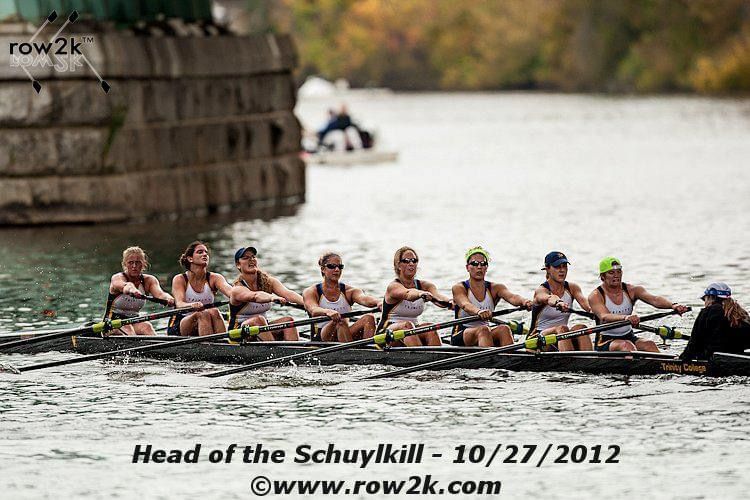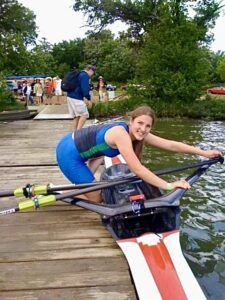This piece is part of our PANpov series — firsthand stories from employees about personal experiences. Read more.
As I write this blog, I’m having an Inside Out moment of reliving a core memory. It’s an early morning practice with my rowing coach in Sugar Land, Texas. We’re in a two-seater boat – or what we would call a double scull – gliding across the lake.
Ever wind up a toy and set it free? It glides smoothly; but under the surface, the motor mechanics are going wild. In that boat with my coach, I’m in the leader’s seat or the stern – the one who sets the tempo for the rest of the team. Like the windup toy, I’m the motor in this scenario. My coach is the windup key. I can hear him saying to me in an assertive British accent: Let’s go, Harvey!! Place in the oar, catch and push with the legs. Breathe. Relax the fingers, ease up for the next stroke, and then accelerate. Move the boat.
There’s a motivational poster that shows a rowing team on the water at sunrise. In the lower third of the poster there are capital letters spelling out TEAMWORK and there’s this quote, “Teamwork is the ability to work together toward a common vision. The ability to direct individual accomplishment toward organizational objectives. It is the fuel that allows common people to attain uncommon results.”
My story leans into the latter half of the quote: The ability to direct individual accomplishment toward organizational objectives.
First, let’s time out for a quick lesson in rowing to help understand the point of this blog.
The seating capacity of rowing shells or boats ranges from a single person to eight people. In the largest boat, there’s a coxswain (cox for short) who sits at the stern of the boat with a microphone, coaching the rowers on the tempo all the way through the finish line. When you’re without a cox, the coaching falls on the individual or individuals to move the boat. This is where teamwork in the sport is really tested, and you find your own individuality in a team sport.
By individuality I mean strengths and weaknesses and understanding where you need to lean on your team. When you’re in a boat of eight people, you can’t easily change course and do your own thing. The oars are physically locked in the boat. Nothing will get accomplished. As a callback to the TEAMWORK poster: it’s directing one’s achievement towards the team’s purpose. Move the boat as one.

Evidence of my team and I moving the boat as one.
Take it from my fictional childhood ice hockey coach Gordon Bombay from The Mighty Ducks film trilogy, who repeats to his team that “ducks fly together.” In rowing, it’s the equivalent of saying “Heads in the boat.” There will be external and internal distractions during a race. It’s the rowers’ jobs to keep their heads in the boat so they don’t lose sight of what’s impacting the team that could determine the outcome of a race. Ultimately, the sign of progress to the success stage is achieving the “swoosh” sound of a fast boat that’s built off everyone’s determination to move the boat. It’s the best sound and feeling I’ve had the privilege of experiencing.
This “swoosh” applies to the working world and to finding that sense of accomplishment as a team that shaped me into the professional I am today. Before I get into the adult-working athlete in me, you need a backstory of my growth journey as a team player.
I’ve been an athlete since I was six years old playing on soccer, basketball, volleyball, and softball teams. At age 16, I first learned how to row. Growing up in Houston, Texas, rowing as a sport wasn’t easy to find, so how did it find me? My parents were raised in the Northeast where competitive rowing – or crew, as it’s often called in the United States – has a larger presence. As I hit my growth spurt at 5 foot 9 inches, my parents saw the opportunity for me to pick up the sport with the potential of seeing it as a passion to pursue in college. Side note: Being tall has an advantage for rowers to achieve more leverage and power output to move the boat through the water.
Before my last year of middle school was over, I was signed up for a summer camp at Rutgers University in New Jersey to understand the fundamentals of the sport. My athletic ability only grew stronger as I continued to travel to more summer camps (University of Michigan and Yale University). I eventually was able to find a club team in Sugar Land (an hour drive from Houston) and find my coach who would go on to train me and make me fit for competitions.

Pictured: Me at a regatta in high school!
As a result of traveling to various training camps and earning awards at regattas (rowing competitions), I found myself talking with college coaches and working through the recruitment portal, receiving offers as part of the recruitment process. Before reaching my final semester as a high school senior, I was recruited to row at Trinity College in Hartford, Connecticut. After my early training years of rowing competitively in singles in high school, I would soon find myself having to adapt to an eight-person boat for a Division 1 program – a team of 50 women earning their spot on the A-Team or Varsity squad. From that moment on, I was collecting life lessons like Infinity Stones.
Well dear readers, we’ve reached the bridge to the crux of the blog. After a decade of competitive rowing, I’ve taken away three lessons, all factors of moving the boat, that I’ve incorporated in my life as a working professional.
Lesson #1: Pain Is Temporary
My coaches would say if you’re not out of breath at the end of a race or a workout, you didn’t put in a hundred percent effort because there’s still an ounce of energy in you to do more. When thinking about my work, we not only brainstorm various strategies to execute a plan but also develop pitch abstracts to announce a new product or industry report to the media. It’s the hundred percent effort and mindset to leave no stone unturned knowing you did everything you could.
The road to success isn’t easy and often can be painful. But the bigger the output, the greater the reward. Yes, it’s painful when the vision you planned out doesn’t go your way, but redirection can take you to new places with new heights. In rowing you’ll get calluses and blisters as you’re putting in the strength training, but that pain is temporary because the strength grows within and empowers you. You don’t know your limits unless you go for it.
Lesson #2: The “We” Power in Teamwork
The saying goes, “There’s no “I” in “Team.” My blog stands on the contrary since I talk about the “I” of individuality in a team sport. Yet when you add the “work” to the word team, individualism is important for defining the “we” power in teamwork. It takes every individual on the team to move the boat or deliver strong results for a PR program. As you’re working on a project, your task will influence another task and another. And that’s the tea-m.
Lesson #3: Take an Extra Breath, Quality over Quantity
I follow the running enthusiast Jonny Davies, and he once said, “Being on the edge of your comfort zone is where life truly begins.” In our work environment, we can reach our limits but it’s an opportunity to challenge ourselves to recharge and push through hardships. That’s when the real work happens. It’s better to do one job well than juggle five when we’re not at our best.

Me bringing home the hardware (aka “quality”) after a successful regatta.
That’s why my high school coach would tell me to take two extra breaths before accelerating. Sometimes you forget to breathe in high pressure situations – it calms you down and brings you back to center and reminds you of the purpose in doing all this in the first place. Take an extra breath. Balance the quality and quantity.
Row smart and move the boat – whatever form the boat takes in your day to day.


